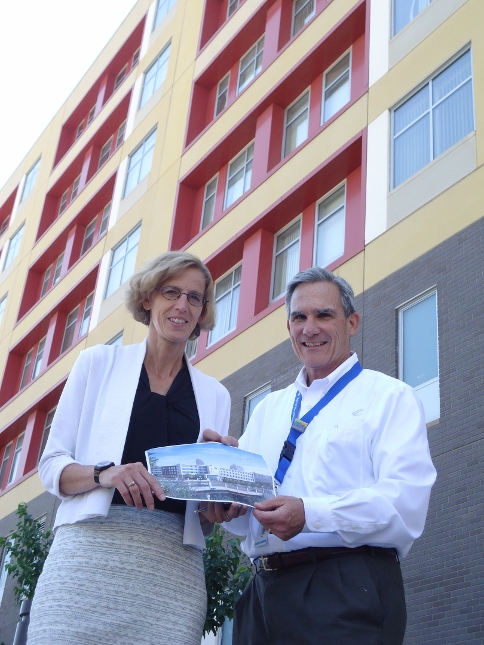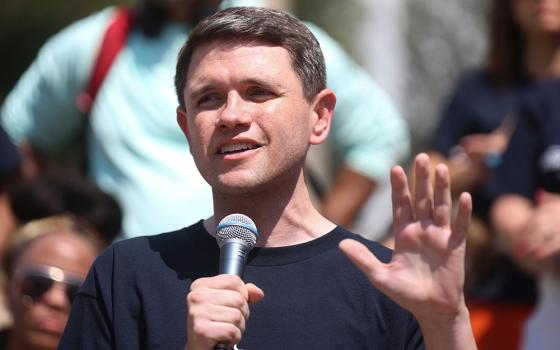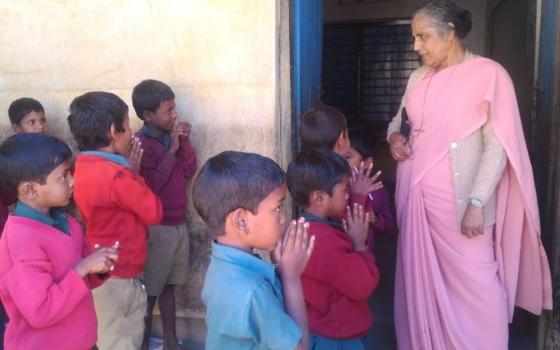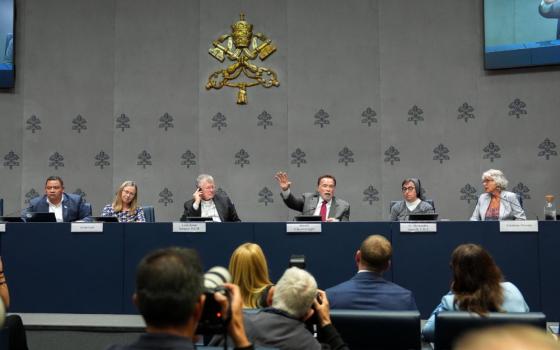
Twin Cities Catholic Charities CEO Tim Marx, right, and Tracy Berglund, senior director of housing stability with Twin Cities Catholic Charities, stand in front of Higher Ground in Minneapolis, holding an artist's conception of the Higher Ground shelter being built in St. Paul. (NCR photo/Joe Winter)
Minnesota officials have announced a possible record-breaking investment in building a new Dorothy Day homeless shelter in St. Paul, at a time when local need may be the greatest ever, said the head of Catholic Charities in that area, the lead agency of the project.
The project is considered unique because of its novel approach to helping homeless people and that it's a public-private partnership, said Tim Marx, the CEO and president of Catholic Charities in the Twin Cities. About 40 percent of the $100 million total cost will be from private funds, which he called a very high ratio.
The Minnesota Housing Agency has earmarked what is easily a state record of $19 million for the project, and multiple other sources are providing additional millions of dollars, such as more than $11 million in funding received from other government sources within Minnesota.
The first phase to replace the current deteriorating Dorothy Day Center has a total price tag of $30 million and should be completed by the end of this year. The second phase, which is set to be finished in 2018, will cost another $34 million, he said.
"We now have the ability to put our pedal to the floor," said Marx, about having funds to spur the project.
The new Dorothy Day site in St. Paul is modeled after the award-winning design of the Higher Ground homeless shelter built in neighboring Minneapolis in 2012, according to Marx. Both its architectural footprint and rethinking of ways to serve the homeless are considered a model for other shelters around the country.
The existing Higher Ground facility is by far the biggest part of the campus, which has multiple buildings, some meeting specific client needs such as alcohol addiction.
That cornerstone building is a seven-story high-rise with each level serving clientele with differing needs. The services provided include job training and medical referrals, and they go far beyond just sleeping space -- though the center is full every night and in the winter of 2014-2015 began opening seasonal overflow space at the earliest time ever, Marx said.
It's telling that homelessness in Minneapolis-St. Paul has been at its worst, hitting record numbers only in the last couple of years, despite that the recent recession began way back in 2007, Marx said. "When the recession ebbed, we had hoped that the need for emergency shelter would have gotten better."
Those thoughts were expounded on by Ernest Goss, professor of economics at Creighton University in Omaha, Neb., who specializes in regional quality-of-life issues to do with the economy.
"Minneapolis and St. Paul have recovered much more than their [Midwest] neighbors in, for example, Milwaukee and Detroit and Des Moines," Goss said. He added that cities in many other areas of the country, such as in what's known as the "Rust Belt" in states to the immediate southeast, were hit even harder by the economic downturn. He cited the status of manufacturing, usually the major employer, in many such cities.
The allocation by the Minnesota Housing Agency, a quasi-governmental entity that was a key part of the new Dorothy Day funding, also includes a record amount of other emergency housing project funds in the state, totaling $162 million for 78 projects and 4,000 housing units in the Twin Cities and surrounding area, Marx said. Officials from various agencies say that even with this money, $100,000 of which was made available with state bonding funds, not all local emergency housing needs are met.
There are at least 14 different agencies in the partnership to build the new Dorothy Day shelter, which will be formally known as Higher Ground St. Paul, that combine public and government monies and from private sources such as donations and business gifting, Marx said, adding that this diversity is seen by local officials as a strength, not a church-versus-state conflict of interest.
"What is unique about this project is the amount of private support we're bringing to the table," Marx said.
The St. Paul version of Higher Ground, which broke ground in summer 2015, adjacent to the former Dorothy Day Center, which is being torn down, will offer 278 shelter beds and 193 single-room units. Between the two Higher Ground centers, housing available in the Twin Cities for homeless people will double to serve 359 individuals.
Catholic Charities opened the Dorothy Day Center in 1981 as a drop-in center for meals, serving about 40 clients each day, Marx said, adding that over time, due to increased homelessness, it was forced to become a fulltime overnight shelter.
Hundreds of people sleep on mats on the floor each night, and the center is overcrowded and deteriorating, Marx said. The number of people relying on the center has grown to more than 6,000 a year, with more than 81,000 nights of shelter provided.
At the current facility, a photo ID card is issued to clients, which lets officials track the services clients receive and better plan ways to serve them, Marx said.
The existing Higher Ground has a gathering area with sets of doors on either side, so people can be inside during intake processing. Once admitted, they can utilize various levels of services beyond the usually provided meals, including showers, computer lab, laundry facilities, storage and legal services.
The ante will be upped in St. Paul, where phase two will also create a next-door "opportunity center" that will serve 450 people a day, giving them access to a medical clinic, veteran's services, on-site county social workers and likely employment training, GED assistance and even a barber chair to spiff people up for job interviews, Marx said.
The Higher Ground in St. Paul will have more green space than its predecessor, including rooftop gardens that will provide ambiance for neighbors in high-rises, and a better courtyard, where soon-to-be clients can wait on benches under shade trees and a rain canopy, Marx said.
The Minneapolis facility has been built alongside a popular urban bike trail to allow transport to services and work, and plenty of natural light has been included in the design. "Studies have shown that this decreases the number of [conduct] incidents that occur," Marx said.
The clients created some of the art on the walls, part of that a mural depicting their situations and how they have been aided.
Next to the two-high bunks for emergency need on the first floor, surrounded by open space, a modicum of privacy is afforded where clients can stow backpacks and check messages, often an employment tool, by plugging in cell phones. Tenant coaches are available on that level, as is weekly linen service and meals at a scant cost.
There is a pay-for-stay option on some upper floors where a $7 nightly fee gives access to slightly nicer bunk beds, with a dollar being taken off if a client stays for a week. This is one of several options where monies are held in trust and can be used later for things like first month's rent on an apartment, Marx said. It also enables clients to have their own locker, access to a mailbox, and computer usage to look for work, said Tracy Berglund, senior director of housing stability with Twin Cities Catholic Charities.
On the very top floors at both Higher Ground facilities will be regular-size, single rooms with a couple of small appliances, such as a refrigerator, and closet space. There's a lounge, and though clients do not have televisions supplied in any of the rooms, they can bring their own in, officials said.
In about three years, 294 of such pay-for-stay clients have transitioned to more traditional housing -- the ultimate goal -- and until then, 70 percent of them hold jobs, Marx said. At the current Higher Ground, there are 85 such single rooms on floors three through seven, with permanent supportive housing for the long-term homeless.
"It is important to allow people to be comfortable, but not too comfortable," Marx said, or they may desire to simply stay put. The goal is to be a transformational situation and move clients out into the regular community and to its workforce and housing.
All clients have access to a case manager, as a part of the county services that are afforded, Marx said. Permanent housing specifically for youth at risk of becoming homeless and dedicated space for the specific needs of women are planned.
Marx is quick to add that helping people become self-sufficient all starts with housing, although there can be a strong need to do something shorter-term such as get a car fixed, which can lead to keeping a job, which can lead to keeping a house -- meaning less need to overflow homeless shelters.
The current Higher Ground site in Minneapolis was an experiment, and officials' experience will be tweaked and improved when building the version in its neighboring city, Marx said. However, he added its success has led to the Twin Cities' having only 200 homeless veterans, the number of which in most cities is a more troublesome demographic, since veterans can comprise a large volume of the client caseload.
"The investment being made here in St. Paul will help to insure the dignity of all people ... which are vital to the city's future growth and success," St. Paul Mayor Chris Coleman said in a statement.
"This project has transformational potential," said Richard Schulze, founder of the Best Buy chain of electronics stores, whose family foundation made a substantial donation to the Higher Ground being built. "It represents the very best thinking, innovation and commitment not only to address the urgent crisis of homelessness today, but also, perhaps more importantly, to prevent its causes and open doors to greater self-sufficiency and opportunity for all."
[Joe Winter is a freelance writer who lives in Hudson, Wis.]



